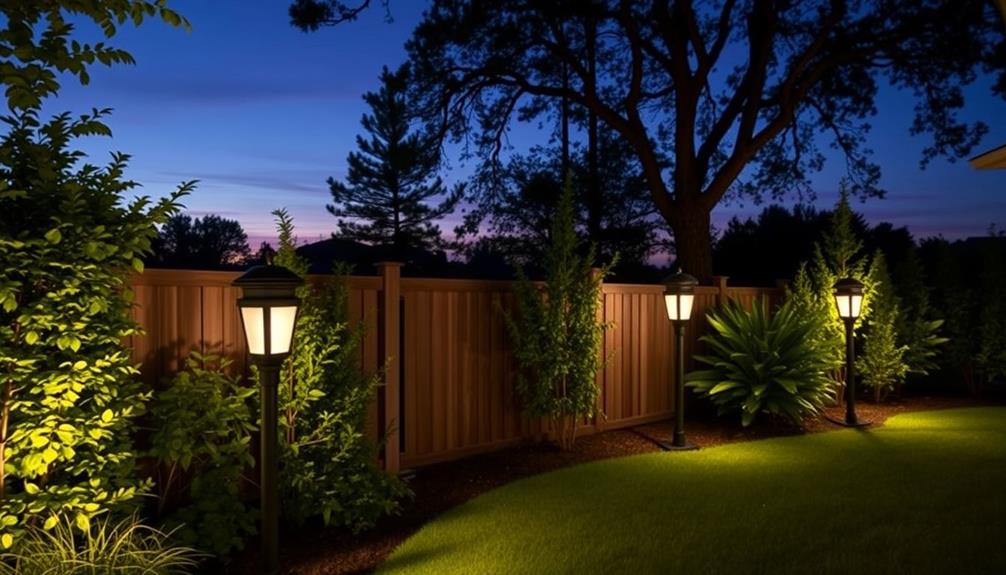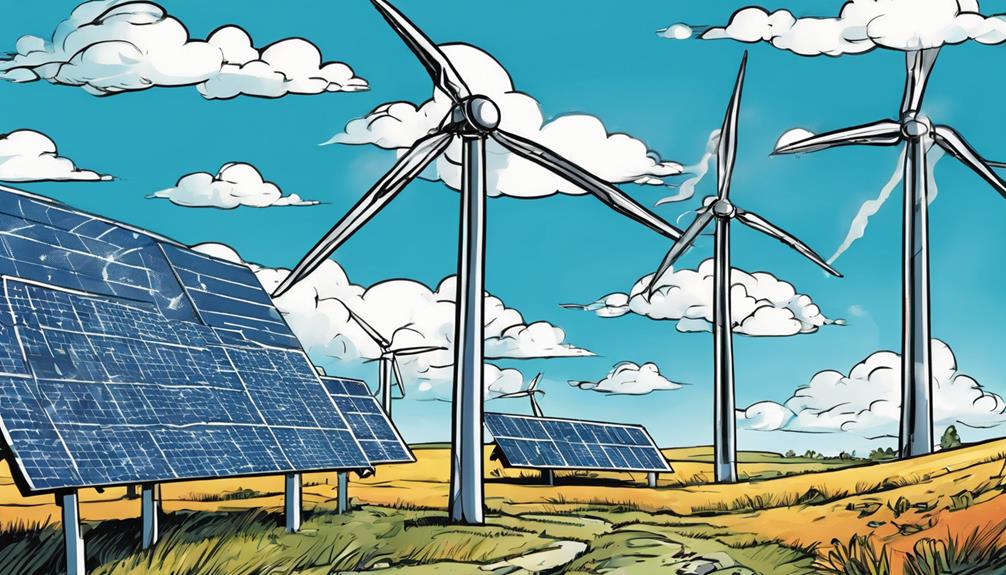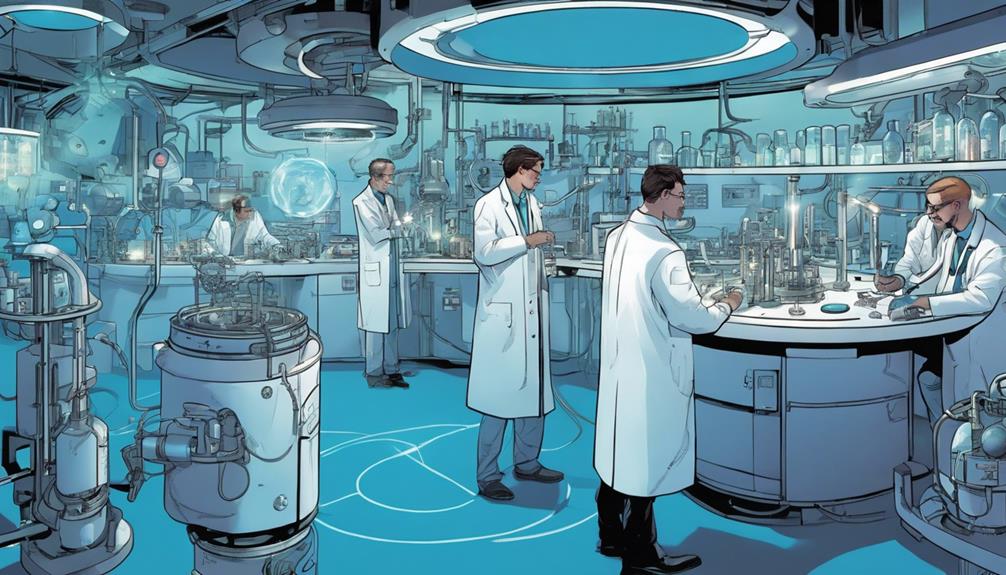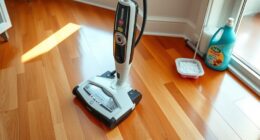Harnessing wind energy with a home windmill generator can change how you power your living space. You'll enjoy significant savings on your electricity bills while reducing your carbon footprint. Small wind turbines can generate between 1 kW and 100 kW, making them great for residential use. With incentives like tax credits, the upfront costs become more manageable. Plus, investing in wind energy boosts your property value and offers energy independence. If you're keen to discover how this technology works and the best options for your setup, there's plenty more to explore.
Key Takeaways
- Windmill generators can significantly reduce electricity bills and enhance energy independence by producing renewable energy for homes.
- Small wind turbines range from $15,000 to $75,000, with potential long-term savings and a 30% federal tax credit available.
- Ideal installation locations include rural areas with average wind speeds above 10 mph and minimal obstructions.
- Proper blade design and tower height are crucial for maximizing wind energy capture and efficiency.
- Wind energy contributes to sustainability by lowering greenhouse gas emissions and increasing property values in environmentally conscious communities.
Overview of Wind Energy

Harnessing the power of wind energy offers a sustainable solution for homeowners looking to reduce their electricity costs and environmental impact. Throughout history, wind energy has been utilized in America, evolving from early methods to modern small wind turbines that use advanced materials for better efficiency.
These small wind turbines, defined by the Energy Department as generating between 1 kilowatt and 100 kilowatts, are a niche segment in the renewable energy market. With advancements in technology, including AI-driven smart grids, homeowners can optimize energy flow and enhance reliability.
In the U.S., there's an impressive potential of approximately 1,400 gigawatts of small wind energy. Many homeowners and DIY enthusiasts have tapped into this distributed wind power.
With the average cost of residential electricity at about 17 cents per kilowatt-hour as of June 2023, investing in home wind turbines has become more and more appealing. By installing a small wind system, you can greatly decrease your reliance on the grid and lower your energy costs.
Plus, there are incentives like tax credits and grants available to encourage this shift. Embracing wind energy not only benefits your wallet but also contributes to a greener planet.
Benefits of Windmill Generators

Windmill generators offer you significant cost savings by reducing your electricity bills while providing a sustainable energy source.
By incorporating efficient renewable energy solutions like wind power, you can also contribute to transforming your garden with easy composting and improving your home's overall sustainability.
You'll also enjoy increased energy independence, as these systems lessen your reliance on the grid.
Plus, investing in wind energy contributes positively to the environment, making it a win-win for both your wallet and the planet.
Cost Savings Potential
Investing in a small wind turbine can lead to significant cost savings on your electricity bills. With a 15-kilowatt turbine, you could generate up to 45,000 kWh annually under ideal conditions, dramatically offsetting your utility consumption.
Understanding common financial terms related to energy investments can help you make informed decisions. The upfront cost for small wind turbines typically ranges from $3,000 to $8,000 per kW, but the Inflation Reduction Act offers a 30% federal tax credit, making this investment more manageable.
If you're handy, consider a DIY wind turbine project. You can build one for around $140, a fraction of the cost of commercially produced models, which run between $750 and $1,000.
By generating your own electricity, you not only cut costs but also increase your property value and gain energy independence, especially in rural areas where utility prices can be steep.
Long-term savings can vary, with payback periods ranging from 6 to 30 years based on your energy consumption and local wind conditions.
Environmental Sustainability Impact
Clean energy from wind generators plays an essential role in promoting environmental sustainability. By harnessing wind power, you can considerably reduce your household's greenhouse gas emissions, which is essential for combating climate change. Shifting to renewable energy sources like wind not only decreases your reliance on fossil fuels but also supports a larger change towards sustainable energy practices.
Additionally, investing in alternatives like Gold IRAs can provide financial resilience while supporting eco-friendly initiatives.
Installing windmill generators can lower your electricity bills, as they help offset energy consumption from the grid. This reduction in energy use leads to a smaller carbon footprint, making your home more eco-friendly.
Additionally, combining wind energy with solar systems can optimize energy production, especially when wind is stronger at night. This integration enhances your overall sustainable energy use.
Investing in windmill generators also positively impacts your community. It can increase property values and stimulate local economies by promoting the adoption of renewable energy technologies.
Energy Independence Benefits
Harnessing wind energy at home offers considerable benefits for achieving energy independence. By installing a windmill generator, you can dramatically cut your electricity bills, as a 15-kilowatt turbine can produce up to 45,000 kWh annually under ideal conditions. This renewable energy source helps offset your home energy consumption, allowing you to rely less on grid-supplied electricity, particularly beneficial if you live in rural areas prone to power outages.
Additionally, many investors are looking for ways to diversify their portfolios, and exploring options like precious metal investments can complement your sustainable energy initiatives.
Investing in wind energy is a long-term economic solution. With an average payback period of 6 to 30 years, depending on local wind conditions, the savings can be substantial. Plus, you can take advantage of federal tax credits of 30% under the Inflation Reduction Act of 2022, considerably reducing installation costs.
Additionally, small wind systems can enhance your property value. They not only provide sustainable energy but also signal a commitment to energy independence, appealing to environmentally conscious buyers.
Key Components of a Windmill

When you're setting up a windmill, understanding the key components is essential. Each element, from the generator to the blades, greatly influences the overall efficiency of energy harnessing.
You'll need to take into account generator selection criteria, explore effective blade design methods, and grasp the essentials of tower construction.
Engaging in creative problem-solving can also enhance your design process. Each part plays an important role in harnessing wind energy efficiently for your home.
Generator Selection Criteria
Selecting the right generator for your windmill is essential for optimizing energy production. When considering the generator selection criteria, prioritize a permanent magnet DC motor, like the cost-effective Ametek 30-volt model, which can generate several hundred watts.
Make sure the generator's voltage aligns with your wind energy system requirements; while a 99-volt model is ideal, alternatives like the 30-volt motor can still perform effectively. A well-selected generator can greatly enhance your energy generation, much like how IRA rollovers to gold can protect retirement portfolios.
Compatibility is key—your generator must work seamlessly with your chosen blades and hub design to maximize power output. A well-matched system enhances energy conversion, allowing you to harness wind energy efficiently.
Additionally, evaluate the generator's overall design, confirming it can handle varying wind speeds and withstand environmental conditions. Durability is critical for long-term performance.
Don't forget to integrate a charge controller with your generator setup. This component is essential for managing battery charging and preventing overloads, which helps maintain the longevity of your entire wind energy system.
Blade Design Methods
A well-designed blade can greatly enhance the efficiency of your windmill, directly impacting its energy production. Blade design is vital for optimizing energy conversion in your wind turbine. Airfoil shapes improve lift while reducing drag, making your turbine more effective at harnessing wind energy.
When considering blade materials, options like wood, fiberglass, and PVC are common. Many DIY enthusiasts favor the PVC pipe method for its efficiency and ease of construction. Blade dimensions vary, but a typical size for small turbines ranges from 6 to 12 inches in diameter and 24 to 48 inches in length, depending on your specific power requirements.
The angle and curvature of blades play a significant role in performance. Here's a quick overview of different blade designs:
| Blade Type | Key Feature |
|---|---|
| Airfoil Design | Maximizes lift and minimizes drag |
| Straight Blades | Simplicity and ease of construction |
| Curved Blades | Enhanced energy conversion |
| Variable Pitch | Adapts to wind conditions |
With properly shaped blades, you can generate several hundred Watts of power. Effective blade design is imperative for maximizing your wind energy output.
Tower Construction Essentials
To guarantee your windmill operates efficiently, understanding the key components of tower construction is fundamental. The tower height should be at least 30 feet to maximize wind capture, reducing interference from nearby structures. This height guarantees your turbine can harness the strongest winds, ultimately enhancing energy production.
Additionally, implementing a high-efficiency rating in your windmill design can further increase energy output, similar to how modern wood pellet stoves optimize fuel use.
For a stable and durable tower base, consider using a combination of materials like iron pipes and EMT conduit. These materials can withstand various weather conditions, providing longevity to your structure.
Additionally, proper anchoring techniques are essential. Using nylon ropes and wooden stakes will help maintain plumb alignment during installation and throughout the windmill's life.
You might also want to design your turbine tower for easy raising and lowering functionality. This feature allows for simple maintenance and adjustments without the need for extensive disassembly, saving you time and effort.
Lastly, don't overlook zoning regulations and permitting requirements. These can notably impact your tower's design and construction. Make sure you research and comply with local regulations to avoid any potential setbacks during installation.
Building Your Own Wind Turbine

Building your own wind turbine can be a rewarding project that not only saves money but also contributes to sustainable energy. A DIY wind turbine typically costs around $140.62, a fraction of the price of commercially made turbines, which can range from $750 to $1000. Here's a simple breakdown of essential components:
| Component | Description |
|---|---|
| Generator | 30-volt Ametek motor |
| Blades | Airfoil-shaped blades from ABS pipe |
| Charge Controller | Manages battery charging |
| Tower Height | Ideal height of 30 feet or more |
When building your own wind turbine, remember that effective blade design is essential for performance. You can use PVC pipe for easy construction. Additionally, the tower height greatly affects wind capture, so place your turbine at least 30 feet high to avoid obstructions.
Regular maintenance is also important; check for corrosion and lubricate moving parts to keep your turbine operating efficiently. With proper care, your DIY wind turbine can last over 20 years, making it a sustainable and cost-effective energy solution for your home.
Optimal Locations for Wind Energy

To harness wind energy effectively, you need to find locations with ideal wind conditions, typically in rural areas where average wind speeds exceed 10-11 mph.
Incorporating natural elements in your setup can enhance the aesthetic and functional aspects of your wind energy system, similar to how DIY Fire Pit Ideas can transform outdoor spaces.
Assess your site for minimal obstructions like trees and buildings, ensuring your turbine can capture the maximum amount of wind.
Ideal Wind Conditions
When considering wind energy for your home, it's vital to recognize that effective power generation hinges on ideal wind conditions. To harness wind energy efficiently, you'll need an average wind speed of at least 10-11 mph (4.5-5 m/s).
Areas with minimal obstructions—like rural locations free from trees and buildings—are perfect for installing small wind turbines. This setup maximizes wind capture and guarantees you get the most out of your investment. Additionally, similar to how water parks provide diverse experiences for families, selecting the right location for your wind turbine can enhance the efficiency of energy generation.
Furthermore, it's important to elevate your turbine at least 30 feet above nearby structures to minimize turbulence and improve wind flow. States such as New York, Minnesota, Texas, and South Dakota boast some of the best wind resources in the U.S., providing considerable potential for generating electricity per year.
Before diving into installation, conduct a wind resource assessment to gauge the average wind speed and site clearance. These factors will greatly influence your energy production and help you determine if wind energy is a viable option for your home.
Site Assessment Criteria
For ideal wind energy generation, evaluating your site is fundamental. A thorough site assessment guarantees you'll harness the maximum potential of your wind system. Here are three key criteria to evaluate:
- Wind Speed: You need an average wind speed above 10 mph. This amount of wind is essential for generating sufficient electricity per year and enhancing your turbine's performance.
- Location: Choose a rural area, free from obstructions like tall buildings or trees. This allows for unimpeded wind flow, which is critical for efficiency.
- Height of Installation: Install turbines at least 30 feet above nearby structures. This height captures ideal wind currents and reduces turbulence, greatly improving energy production.
Additionally, always check local zoning regulations and permitting requirements, as these can vary greatly by location.
Confirming that your property meets these criteria not only increases the feasibility of your wind system but also maximizes your potential savings on electricity costs.
Installation and Maintenance Tips

Installing and maintaining a wind energy system at home requires careful planning and attention to detail. To guarantee peak performance, it's recommended you hire professionals for the installation. They'll help you comply with local electrical codes, avoiding inefficiencies or hazards. Start with a wind resource assessment; your site should have an average wind speed of over 10 mph to maximize your turbine's effectiveness.
Here are some tips for installation and maintenance:
| Tip | Details | Frequency |
|---|---|---|
| Wind Resource Assessment | Confirm wind speeds exceed 10 mph for efficiency. | Before installation |
| Professional Installation | Hire experts for safety and compliance with codes. | Once (initial setup) |
| Height Requirements | Install turbine at least 30 feet above structures. | Once (initial setup) |
| Regular Maintenance | Inspect bolts, corrosion, and moving parts. | Every 6 months to 1 year |
Cost Analysis and Savings

After ensuring your wind energy system is installed correctly, it's important to contemplate the financial aspects. Understanding the cost analysis can help you see the long-term savings that wind energy can bring to your home.
- Upfront Costs: While installation costs for small wind turbines can range from $15,000 to $75,000, building your own turbine could cost as little as $140.62.
- Incentives: Financial incentives like the 30% federal tax credit under the Inflation Reduction Act can greatly reduce your initial investment.
- Energy Bill Reduction: With electricity costs averaging around 17 cents per kilowatt-hour, shifting to wind energy can lead to substantial monthly savings.
Your savings don't stop there. Depending on local wind conditions and your household energy use, the payback period for your investment could range from 6 to 30 years.
This means that, after your initial investment, you could enjoy lower electricity bills for years to come. By investing in wind energy, you're not just saving money; you're also contributing to a more sustainable future.
Start your journey towards energy independence and financial relief today!
Comparing Wind and Solar Energy

When choosing a renewable energy solution for your home, comparing wind and solar energy is essential.
Solar power tends to be more widely adopted due to its ability to generate energy in various conditions. While wind energy systems require an average wind speed of 10-11 mph or higher to be effective, solar panels can produce energy even on cloudy days.
Financially, solar systems are generally more accessible. The average installation cost for solar in the U.S. is around $2.86 per watt, whereas small wind turbine systems can start at about $30,000. This difference makes solar a more feasible choice for many homeowners.
In terms of energy output, a well-situated 15-kW wind turbine can generate up to 45,000 kWh annually, but smaller systems may struggle to meet your needs.
Solar installations, on the other hand, offer customizable solutions tailored to your specific energy requirements.
Combining both wind and solar technologies could yield the best results, harnessing the power of wind at night while taking advantage of solar energy during the day.
This hybrid approach maximizes your energy generation potential and can lead to greater savings in the long run.
Future Trends in Wind Power

Harnessing the latest advancements in wind turbine technology, homeowners can look forward to a future where wind power becomes a more viable energy solution.
With new turbine models featuring only two moving parts, you could see generation costs drop by over 50%. This makes investing in small turbines even more attractive as the average U.S. electricity cost hovers around 17 cents per kilowatt hour.
Here are three reasons to contemplate wind energy for your home:
- Affordability: With reduced generation costs, wind power becomes a financially smart choice.
- Increased Production: U.S. manufacturers are now producing around 5,000 small turbines annually, enhancing availability.
- Community Collaboration: Local energy groups are joining forces to finance projects, making wind powers a realistic option alongside solar.
As technology continues to advance and prices fall, wind energy may outshine solar in areas with strong winds.
So, prepare for a future where harnessing wind energy isn't just a dream, but a practical and economical reality for your home.
Embrace the potential of wind and solar, and take control of your energy future!
Real-Life Success Stories

Discover how real-life success stories are bringing wind energy into homes across the country. One remarkable project in Arizona showcases the potential of small, DIY wind turbines. Using a simple $26 Ametek motor, this home-built solution generated several hundred watts, proving that off-grid living is within reach for many.
Campers even powered essential devices like laptops and phone chargers, highlighting the practical applications of wind energy in remote settings.
The economic benefits are significant, too. This DIY project saved over $140 compared to commercial turbines, which often range from $750 to $1,000. It emphasizes that personal wind energy solutions can be both effective and affordable.
By integrating a small wind turbine with solar panels, this system guaranteed a consistent power supply, maximizing energy generation and efficiency.
Furthermore, small wind systems can dramatically lower electricity bills. A 15-kW turbine, under ideal wind conditions, could generate up to 45,000 kWh annually, making it a valuable investment for homes situated in suitable locations.
These success stories illustrate that harnessing wind energy isn't just a dream—it's a reality you can achieve!
Frequently Asked Questions
Can a Windmill Generate Enough Power for a House?
Yes, a windmill can generate enough power for your house. If you choose the right size, like a 5-15 kW turbine, you'll effectively reduce electricity bills and decrease reliance on the grid.
How Big of a Wind Turbine Do I Need to Power My House?
To power your house, you'll need a wind turbine between 5 to 15 kilowatts. This range guarantees you generate enough energy, especially if your home consumes around 10,649 kWh annually and wind conditions are suitable.
Are Home Wind Turbines Worth It?
Yes, home wind turbines can be worth it if you've suitable wind conditions. They lower electricity bills, increase property value, and offer sustainability. With incentives, the upfront costs become manageable, making them a smart long-term investment.
How Much Does It Cost to Install a Wind Turbine at Home?
Installing a wind turbine at home isn't cheap; it typically costs between $15,000 and $75,000. However, tax credits can lighten the load, and you could see savings in 6 to 30 years.
Conclusion
Imagine standing in your backyard, the gentle whir of your windmill generator filling the air as it harnesses the breeze to power your home. You've taken a step toward sustainability, embracing the whispers of the wind to reduce your energy bills and your carbon footprint. With every rotation of the blades, you're not just generating electricity; you're becoming part of a brighter, greener future. So why wait? Immerse yourself in the world of wind energy and feel the power at your fingertips! Harnessing the wind’s energy not only benefits you by saving money and reducing your reliance on fossil fuels, but it also has a positive impact on the environment. The environmental impact of wind power is significant, as it produces no greenhouse gas emissions or air pollutants, helping to combat climate change and improve air quality. By investing in a windmill generator, you’re not just improving your own life, but also contributing to a cleaner, healthier planet for future generations.










